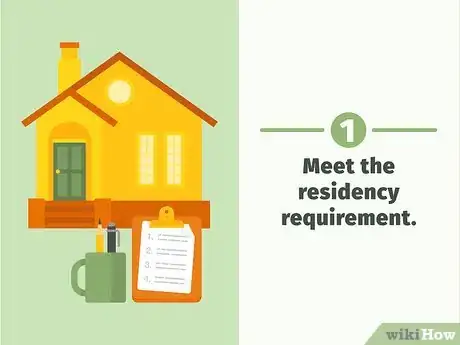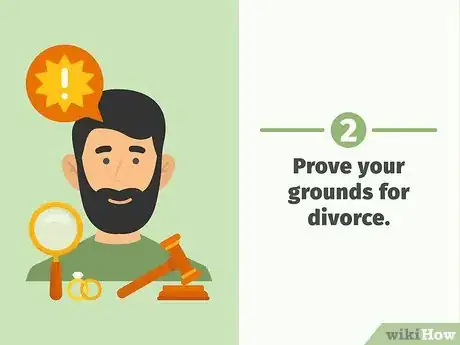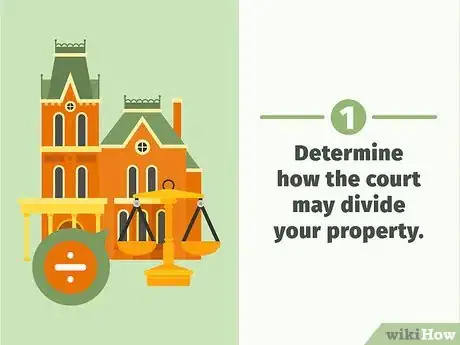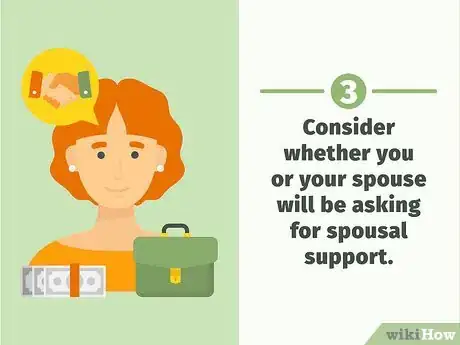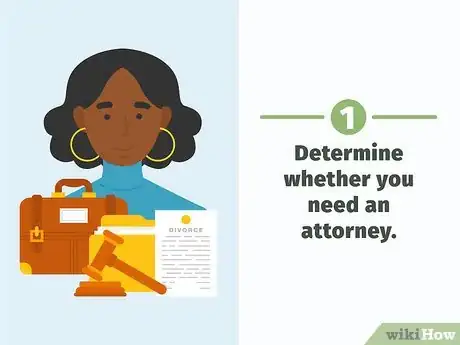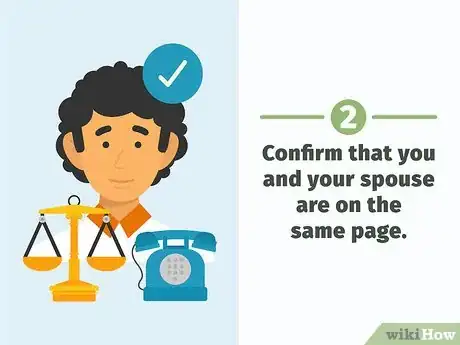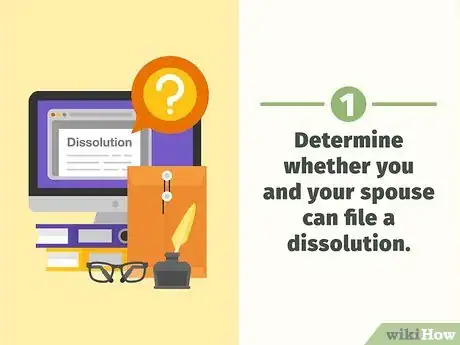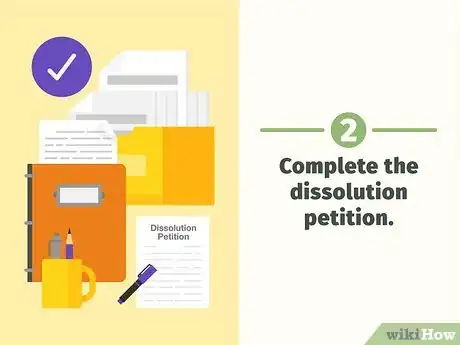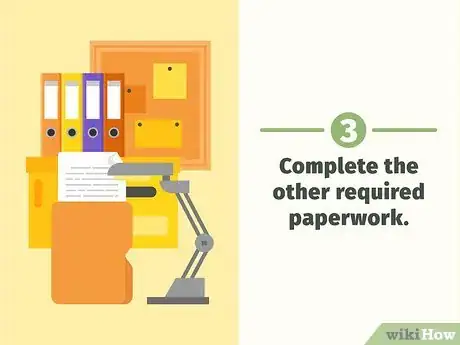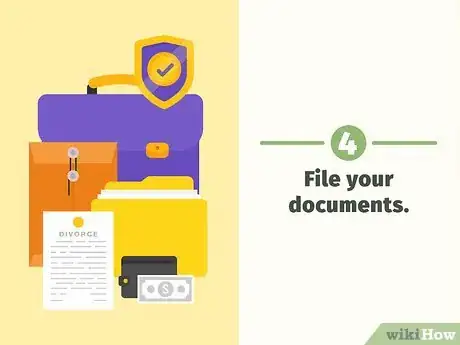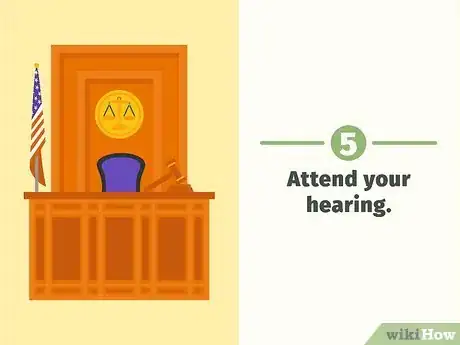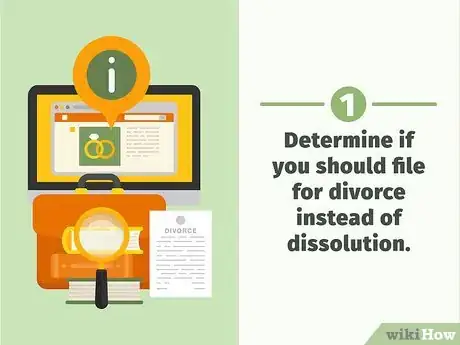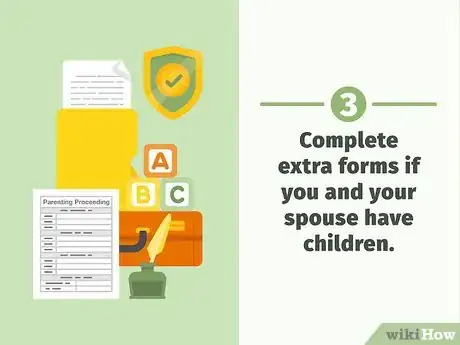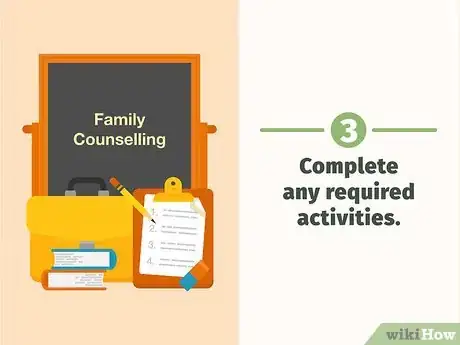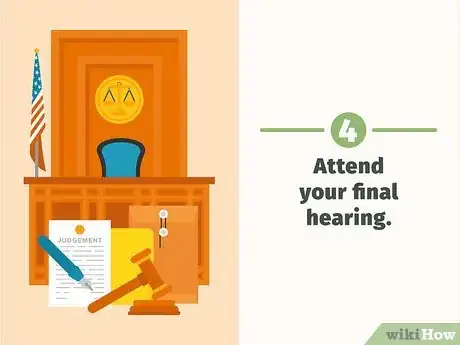This article was co-authored by Clinton M. Sandvick, JD, PhD. Clinton M. Sandvick worked as a civil litigator in California for over 7 years. He received his JD from the University of Wisconsin-Madison in 1998 and his PhD in American History from the University of Oregon in 2013.
There are 7 references cited in this article, which can be found at the bottom of the page.
wikiHow marks an article as reader-approved once it receives enough positive feedback. In this case, 100% of readers who voted found the article helpful, earning it our reader-approved status.
This article has been viewed 148,767 times.
If you are a resident of Ohio and want to file for divorce, but do not want the expense of hiring an attorney, you are in the right place. You can file for divorce in Ohio with an attorney by following the steps below.
Steps
Insuring you Qualify for a Divorce in Ohio
-
1Meet the residency requirement. In order to get a divorce in Ohio, either you or your spouse must have lived in Ohio for for at least 6 months prior to filing for divorce.
- Additionally, you must have been a resident of the county where you file for divorce for at least 90 days prior to filing.
-
2Prove your grounds for divorce. Spouses in Ohio need to prove “grounds” in order to get a divorce. However, one of the permissible reasons to divorce is that you and your spouse are “incompatible.” This ground is typically the “no-fault” ground and is easiest to prove. There are other grounds that you can prove as well, including:
- you and your spouse have separated and have lived apart for at least one year,
- your spouse cheated on you during the marriage,
- your spouse was extremely cruel,
- your spouse is currently in state or federal prison,
- your spouse grossly neglected his or her duties to the marriage,
- your spouse was habitually drunk or under the influence of other drugs during the marriage.
Advertisement -
3Find out where to file. You must file a petition for divorce in the court that serves the county where you have lived for at least 90 days prior to filing. This court is where your divorce hearings will take place, and where you will turn in all of your paperwork.
- To find the location of the courthouse that serves your county, visit Ohio’s Judicial Branch website at https://www.supremecourt.ohio.gov/JudSystem/trialCourts/ Judicial Branch Website.
Examining the Issues Present in a Divorce Case
-
1Determine how the court may divide your property. Ohio courts will “equitably distribute” property when a couple divorces. “Equitable distribution” means that the court can distribute all property that either spouse or both spouses have, regardless of whose name it is in and when the property was acquired. [1]
- Property that the court can divide between the parties or award to one party includes: the marital residence, stock options owned by one party, personal injury awards (including workers compensation), inheritance, gifts given to one party, 401k payments and pensions, any property acquired by one or both spouses during the marriage, and property acquired by one or both spouses before the marriage.
- When determining how to divide the property, the court will consider the following: the length of the marriage, the cause of the divorce, the age, health, station, occupation, amount and sources of income, earning capacity, vocational skills, education, employability, estate, liabilities and needs of each party, and contributions of each party to the marriage. [2]
-
2Discuss child support and custody with your spouse if you have children. If you and your spouse have children, the court will come up with a custody arrangement that is in the “best interests of the child.” [3] This could mean that you and your spouse will share custody, or the court could award one party full custody. Additionally, you and your spouse will have to determine each party’s child support obligations based on how the court determines custody.In determining custody, the court will consider the following: [4]
- what both parents want (i.e., do they agree that one parent should have primary custody etc.),
- what the child wants,
- whether either parent plans to move out of state after the divorce,
- which parent is most likely to allow and facilitate a relationship between the child and the noncustodial parent.,
- the failure of either parent to make any past child support payments,
- either parent’s previous conviction or guilty plea for abuse or domestic violence,
- the child’s relationship with parents, siblings, and any other person who may significantly affect the child’s upbringing,
- the child’s attachment to the current community and school,
- the mental and physical health of all those involved.
-
3Consider whether you or your spouse will be asking for spousal support. In Ohio, either spouse may ask for continued support from the other. After divided property, the court has the discretion to award any “reasonable” spousal support. [5] The court will consider many factors when determining whether to award support payments, including: [6]
- the earning capacity of both parties,
- The ages and health of the parties (including physical and mental health),
- Any retirement benefits that the parties have,
- The duration of the marriage,
- Whether one party cannot work due to caring for the children,
- The standard of living that was established during the marriage,
- The education of both parties,
- The assets and liabilities of both parties,
- The contribution of either party to the education or earning capacity of the other (such as if one party was the sole worker while the other was in school),
- The time it would take the spouse seeking the support to get their own education.
Hiring an Attorney
-
1Determine whether you need an attorney. While having an attorney to advocate on your behalf may insure that the divorce process goes smoothly, you may be able to complete the divorce without a lawyer.
- In Ohio, you can visit http://www.ohiolegalservices.org/public/legal_problem/family-law/legal-separation-divorce-and-dissolution/selfhelpct_view/ to learn about the divorce process and the available resources.
-
2Confirm that you and your spouse are on the same page. Typically, if you and your spouse agree on the issues surrounding your divorce, you do not need to hire an attorney.
- For example, if you and your spouse agree on how to divide your property, and if there are no children involved, you can probably file for divorce on your own and save money. If you do not have an attorney, you and your spouse will be responsible for filing all of your paperwork, and will each talk to the judge without getting any help preparing.
- If you and your spouse do not agree on how to separate your property, or if you have children and need to come up with a custody arrangement, you should hire an attorney to assist you. A “contested” divorce where the parties do not agree can be extremely complicated, and you should have an expert to help you get the best possible outcome.
- If you and your spouse agree on the issues surrounding your divorce, you can file for a “dissolution” together using one petition. However, if you do not agree, you will have to file on your own.
-
3Find a qualified local attorney. If you decide to hire an attorney, you should research possible candidates to find one that is right for you. To begin the process, considering doing the following:
- Get a referral from a friend or family member who has used a divorce lawyer before. Find out who they hired and if they would recommend the attorney. If you can’t get a referral from anyone you know, check online websites like Find Law, Avvo, and Yahoo Local to find a qualified attorney.
- Once you have a list of attorneys that you think may be a good fit, set up “consultation” meetings so you can meet face to face. During the meeting, you can ask questions about your case and situation, and gage whether you get along with the attorney.
-
4Choose the right attorney for your situation. After meeting with potential attorneys, decide which one is the best for your particular situation. You should consider the amount of experience the attorney has, the price he or she will charge, and how well you got along with the attorney.
- If, after meeting with an attorney, you think of other questions you would like to ask, don’t hesitate to call back and ask. You should make an informed decision, and the attorney that you are considering should not have any problem answering any and all questions that you may have.
- If you cannot afford an attorney, you can try to obtain legal help on a “pro bono” (free) basis. Ohio offers many services to help low income individuals receive the legal help they need. To see what resources are available to you, visit http://www.ohiolegalservices.org/programs/ and enter your zipcode.
Filing for a Dissolution With Your Spouse
-
1Determine whether you and your spouse can file a dissolution. Filing for a dissolution with your spouse is the easiest and fastest way to end your marriage in Ohio. A dissolution is thought of as a “no fault divorce,” and will take approximately one month. This may be an option for you if you and your spouse both agree that ending your marriage is the best thing for both of you. However, if you want to file a dissolution, you and your spouse must agree on all of the issue surrounding the divorce, including the division of your property, custody and visitation of children, and any spousal support.
-
2Complete the dissolution petition. In order to file for a divorce with your spouse, you must complete a dissolution petition that will be filed with the court.
- To get a copy of the dissolution petition, go to the courthouse in your county and ask the court clerk.
- You can also visit the website for Ohio Legal Services at http://www.ohiolegalservices.org/public/legal_problem/Home/find_local_court_forms_rules/ and search for your county to see if the forms are available online.
- You can look at a sample form at https://www.supremecourt.ohio.gov/JCS/CFC/DRForms/Form14.pdf.
-
3Complete the other required paperwork. In addition to the dissolution petition, you and your spouse will need to fill out the following forms in order to get a dissolution order.
- Affidavit of Income and expenses: this forms asks for information concerning the finances of you and your spouse, along with expenses that you have.
- Property Affidavit: This form asks for information on the property that will be separated in the dissolution action.
- Separation Agreement: This form outlines the agreement between you and your spouse and should be filed along with your petition and the other forms. This form will be given to the judge for approval.
- Judgment Entry: This form will either be provided by you or by the court, and serves as the judge’s order granting your dissolution.
- To get copies of the forms, visit the website at https://www.supremecourt.ohio.gov/JCS/CFC/DRForms/Form15.pdf https://www.supremecourt.ohio.gov/JCS/CFC/DRForms/.
-
4File your documents. After filling out your dissolution documents, you and your spouse should file them in the court that is located in the county where you live. Be prepared to pay a filing fee at the time you file your dissolution petition. The fee will vary based on your county, so make sure you call ahead of time and find out how much you will have to pay.
- Both you and your spouse should go to file the paperwork together so you can “waive service.” Otherwise, both of you will have to serve process on the other, which is a waste of time and money because you both filled out the paperwork together.
-
5Attend your hearing. After you file your documents, you will receive notice of the time and date of your dissolution hearing. The hearing will schedule no sooner than 30 days and no later than 90 days after you file your petition. [7]
- At the hearing, the judge will want to make sure that you and your spouse actually agree on all issues related to the dissolution, so she may want to ask you and your spouse some questions. However, you do not need to specially prepare for the hearing.
- Typically, the judge will approve your dissolution petition at the hearing, effectively ending your marriage. [8]
Filing for Divorce
-
1Determine if you should file for divorce instead of dissolution. If you and your spouse do not agree on the ending of your marriage or the terms associated with the end, you will need to file for divorce on your own instead of filing for a dissolution.
-
2Fill out the required forms. To start a divorce, you will need four court forms: the Complaint for Divorce, the financial affidavit, the affidavit of property, and the Request for Service. You can find all of these forms by visiting the Ohio State Supreme Court website at https://www.supremecourt.ohio.gov/JCS/CFC/DRForms/divorceChildren.asp and downloading the forms you need. [9]
- Divorce Complaint: The complaint tells the court what you want out of the divorce. In the complaint you will tell the judge what type of custody/visitation arrangement you want (if you have children), whether you want spousal support, how you want your property and debts divided, and whether you want to restore your prior name. [10]
- Request for Service: The request for service is how you tell your spouse that you are filing for divorce. Once your spouse receives the summons, they need to respond to your petition. [11]
- Affidavit of Income and Expenses: this forms asks for information concerning the finances of you and your spouse, along with expenses that you have.
- Property Affidavit: This form asks for information on the property that will be separated in the divorce action.
-
3Complete extra forms if you and your spouse have children. If you and your spouse have children, you will need to complete additional forms to file with the court.
- Parenting Proceeding Affidavit: This form asks for basic information about your children and your family situation.
- Health Insurance Information Form: This form asks for information related to your child’s health insurance.
- Additionally, your local court may require you to fill out additional forms, make sure to check with the court clerk for specific requirements.
-
4File your forms. After completing the required forms, you need to file them with the family court in your county. You can file the forms in person by going to the clerk’s office, or you can send them through the mail to the courthouse.
- When you file, you must pay a filing fee. You may pay with cash, by money order, or using your credit/debit card. To find out the fee for your county, call the clerk or look at the local court website.
-
5Serve your spouse. After you file your divorce paperwork, you are required to give your spouse “notice” of the divorce before you file. This is so your spouse knows about the required court dates, and so that your spouse can “answer” your complaint with his or her own. After filing, the sheriff will serve your spouse using the “request for service that you filled out.” [12]
- Additionally, your county may have special service rules, so make sure you ask the clerk about “service of process” when you file your paperwork.
-
6Wait for your spouse to respond to your complaint. Once your spouse has been served with the divorce papers, they will have the opportunity to respond Check with your local court to see how much time your spouse will have to respond, but in most counties, your spouse will have 28 days. To respond, your spouse will file an “answer” or a “counterclaim.”
- Answer: Filing an answer is an opportunity for your spouse to tell the judge which parts of the complaint they agree or disagree with. This will let the judge know what issues need to be dealt with in the divorce.
- Counterclaim, no children: In addition to telling the judge which parts of the complaint they don’t agree with, filing a counterclaim gives your spouse the opportunity to tell the judge exactly what they want. This is similar to the initial complaint.
- Your spouse should also file a “financial affidavit” and a “property affidavit.” These are the same as the forms filed by you.
Finalizing Your Divorce
-
1Schedule your hearing. After your spouse files an answer or a counterclaim, a hearing will be set. Typically, the hearing will be set for a date at least 3 months after you file the petition.
- Additionally, the judge may want to meet with your and your spouse before the date of the hearing to see if you can come to an agreement regarding the divorce terms.
- If you do meet with your spouse before the hearing and you notice that he is represented by an attorney, you should seriously consider hiring one yourself.
-
2Go to mediation. Before your hearing, it is likely that the judge will order or encourage you and your spouse to attend a mediation session to see if you may be able to come to an agreement.
- While at your session, remember that the goal is to solve the issues between you and your spouse and come up with a divorce decree that works for both parties.
- Don’t go into mediation with a mindset that you have to “win” or “punish” your spouse. Instead, you should be prepared to work collaboratively with the mediator and your spouse to come up with a creative solution to your issues.
- If you and your spouse come to an agreement in mediation or negotiation, you will be able to attend your hearing and simply have the judge sign the agreement. However, if you were not able to come to an agreement, the judge will set a date for a trial on the divorce to decide on the terms.
-
3Complete any required activities. If you have children, your local court may require you to take a parenting class or attend family counseling with your spouse and children. Check with the clerk at your local courthouse to see if you will need to complete anything extra because you have children.
-
4Attend your final hearing. If you and your spouse do not come to an agreement on your divorce, even after attending mediation (if the judge orders you to go), then you will attend your hearing and the judge will decide on your divorce at that time. To prepare for your hearing, write out what you want to say to the judge about your divorce, and contact witnesses who may be willing to testify that your grounds for divorce are truthful.
- On the day of your hearing, make sure you arrive to the courthouse early. You should also dress nicely, and comply with any dress code that your local courthouse implements.
- When you get to the courthouse, tell someone in reception where you hearing is going to be and they will be able to direct you. When you get to the courtroom, sit down and wait for the hearing to begin.
- Bring all of your documents to court with you for the judge to look at, and ask the clerk whether you need to bring a "Judgment" for the judge to sign The judgment for can be found and printed by visiting the Ohio Supreme Court's website at https://www.supremecourt.ohio.gov/JCS/CFC/DRForms/Form11.pdf.
- After the hearing, the judge will decide on the terms, and grant your divorce.
References
- ↑ http://www.nolo.com/legal-encyclopedia/ohio-divorce-31703.html
- ↑ http://www.nolo.com/legal-encyclopedia/ohio-divorce-31703.html
- ↑ http://www.ohiolegalservices.org/public/legal_problem/family-law/child-custody/qandact_view
- ↑ http://www.ohiolegalservices.org/public/legal_problem/family-law/child-custody/a-child-cannot-choose-where-to-live/zanes-child-choose.pdf
- ↑ Ohio Revised Code, Title 39, Chapter 3109
- ↑ Ohio Revised Code, Title 39, Chapter 3109
- ↑ http://www.divorcenet.com/states/ohio/ohfaq02
- ↑ http://www.divorcenet.com/states/ohio/ohfaq02
- ↑ https://www.supremecourt.ohio.gov/JCS/CFC/DRForms/divorceChildren.asp
About This Article
You can file for a divorce in Ohio by filing the appropriate petition. If you and your spouse can agree on all of the issues surrounding your separation, like how your finances will be split up, the quickest way to end your marriage is to file for dissolution. However, if you can't agree on the terms, you'll need to file for divorce instead. To file the petition, you’ll need the proper court forms, which you can on the Ohio State Supreme Court website. Fill out all of the forms and file them with the family court in your county. When you file, you’ll have to pay a filing fee as well, which can vary from county to county. If you decide to hire an attorney, one that’s local and qualified by getting a referral from a friend or family member who has used one before. For tips from our Legal co-author about how to prove your grounds for a divorce in Ohio, keep reading.
